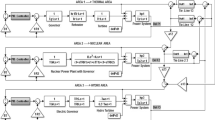Abstract
This paper based on a practice adopted for improvement in the characteristic of frequency deviation of distributed generation-system (DGS) succeeding load and wind trepidation. DGS has very large order transfer function associated with mathematical calculation of frequency-power deviation. So, Reduced order modeling (ROM) of original DGS by means of Logarithmic pole approximation, Markov parameters, and time moments (LPC) help to effective analysis DGS. Three novel optimization algorithms, such as Battle Royal optimization (BRO), Chaotic atomic search optimization (CASO), and grasshopper optimization algorithm (GOA) taken for the first time to obtain optimum parameters associated with PID controller to reach decent dynamic-stability of the considered DGS. The obtained findings show that the suggested control technique algorithms with ROM are able to produce respectable outcomes and significantly increase the stability margin of DGS.



Similar content being viewed by others
References
Ray P K, Mohanty S R and Kishor N 2011 Proportional-integral controller based small-signal analysis of hybrid distributed generation systems. Energy Convers. Manag. 52(4): 1943–1954
Biswas S, Roy P K and Chatterjee K 2022 Performance enhancement of renewable based deregulated system using distributed power flow controller, redox flow battery, and tesla power wall battery. Int. J. Green Energy 1–17
Bhatti T S, Al-Ademi A A F and Bansal N K 1997 Load-frequency control of isolated wind-diesel-microhydro hybrid power systems (wdmhps). Energy 22(5): 461–470
Abraham R J, Das D and Patra A 2007 Automatic generation control of an interconnected hydrothermal power system considering superconducting magnetic energy storage. Int. J. Electric. Power Energy Syst. 29(8): 571–579
Rahman A, Saikia L C and Sinha N 2017 Automatic generation control of an interconnected two-area hybrid thermal system considering dish-stirling solar thermal and wind turbine system. Renew. Energy 105: 41–54
Singh J, Chattterjee K and Vishwakarma C B 2018 Two degree of freedom internal model control-pid design for lfc of power systems via logarithmic approximations. ISA Trans. 72: 185–196
Biswas S, Roy P K and Chatterjee K 2021 Renewable energy-based multi-source system under deregulated environment using cokha algorithm. IETE J. Res. 1–19
Qiu J, Zhao J, Zheng Y, Dong Z and Dong Z Y 2018 Optimal allocation of BESS and MT in a microgrid. IET Gen. Transm. Distrib. 12(9): 1988–1997
Jagatheesan K, Samanta S, Choudhury A, Dey N, Anand B and Ashour A S 2018 Quantum inspired evolutionary algorithm in load frequency control of multi-area interconnected thermal power system with non-linearity. In: Quantum Computing: An Environment for Intelligent Large Scale Real Application, pp. 389–417. Springer
Singh V P, Mohanty S R, Kishor N and Ray P K 2013 Robust h-infinity load frequency control in hybrid distributed generation system. Int. J. Electric Power Energy Syst. 46: 294–305
Biswas S, Roy P K and Chatterjee K 2021 Development of madb of p-i controller using lmi technique in a renewable energy based agc system and study its application in a deregulated environment including energy storage device. Opt. Control Appl. Methods
Guha D, Roy P K and Banerjee S 2016 Load frequency control of interconnected power system using grey wolf optimization. Swarm Evolut. Comput. 27: 97–115
Biswas S, Roy P K and Chatterjee K 2021 Facts-based 3dof-pid controller for lfc of renewable power system under deregulation using goa. IETE J. Res. 1–14
Sambariya D K and Sharma O 2016 Routh approximation: an approach of model order reduction in siso and mimo systems. Indonesian J. Electric. Eng. Comput. Sci. 2(3): 486–500
Vishwakarma C B and Prasad R 2014 Time domain model order reduction using Hankel matrix approach. J. Franklin Inst. 351(6): 3445–3456
Tiwari S K and Kaur G 2016 An improved method using factor division algorithm for reducing the order of linear dynamical system. Sādhanā 41(6): 589–595
Potturu S R, Prasad R and Meshram R 2021 Improved simplification technique for lti systems using modified time moment matching method. Sādhanā 46(3): 1–11
Gupta A and Manocha A K 2021 A novel improved hybrid approach for order reduction of high order physical systems. Sādhanā 46(2): 1–24
Author information
Authors and Affiliations
Corresponding author
Supplementary information
Rights and permissions
About this article
Cite this article
Banerjee, R., Biswas, A. & Biswas, S. Stability analysis of reduced order distributed generation system (DGS) using logarithmic pole approximation. Sādhanā 48, 5 (2023). https://doi.org/10.1007/s12046-022-02050-7
Received:
Revised:
Accepted:
Published:
DOI: https://doi.org/10.1007/s12046-022-02050-7




